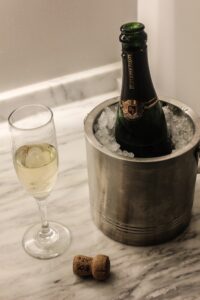 Making your own Champagne (*cough* sparkling wine for us home wine-makers) is not much different from the traditional home wine-making process. By simply substituting your yeast and adding more sugar, you can add bubbles to your favorite wine recipe or concoct a brand new favorite that is best suited as a sparkling wine. Champagnes and sparkling wines can be expensive and we want to help you get the best bubbles for your buck.
Making your own Champagne (*cough* sparkling wine for us home wine-makers) is not much different from the traditional home wine-making process. By simply substituting your yeast and adding more sugar, you can add bubbles to your favorite wine recipe or concoct a brand new favorite that is best suited as a sparkling wine. Champagnes and sparkling wines can be expensive and we want to help you get the best bubbles for your buck.
We know you’ve heard this 1,000 times before, but we are obligated to say it again – most Champagnes available are not truly champagne, but are actually sparkling wines. True Champagne must be produced in the legally identified northern region in France and have the fermentation process (giving the wine its bubbles) occur in the bottle. The Champagne Bureau in Washington, D.C. works to educate U.S. consumers about the uniqueness of the wines of the Champagne region in France and expand their understanding of the importance that location plays in the creation of all wines. You can find out more about the Bureau Du Champagne, USA on their website.
Now that formalities have been established and expectations are set, making your own Champagne (but actually sparkling wine) is an easy addition to the wine-making process and can be done so for a relatively inexpensive cost. Of course, this will be far from the authentic method for making Champagne, but you will get a similar desired effect. Adding a dry white/sparkling yeast will ferment crisp and dry, as well as low in foam, to make your favorite wine recipe bubbly!
Whether the occasion is New Year’s Eve, celebrating a birthday, or just relaxing after a long day, here are two recipes that will be sure to hitch your taste buds on the bubbly bandwagon.
Pro tip: You’re going to need a hydrometer for this champagne recipe.
Essential tools for the job:
• Dry White/Sparkling Yeast
• Bottles (need 6 per gallon)
YOU MUST USE CHAMPAGNE BOTTLES. Regular wine bottles will not even begin to hold the pressure that will be produced.
• Wire Hoods
• Champagne Stoppers
• Champagne Foil Capsules (optional)
Directions:
Step One: Start with your favorite base wine, Follow the The 7 Easy Steps to Make Wine all the way through fermentation. Be sure to use your Dry White/Sparkling Yeast.
Step Two: Siphon the wine into an open bucket after fermentation. The wine should be a little cloudy at this point, add some yeast sediment to the bucket from the bottom of the fermentation bottles if it is not.
Step Three: Make and add simple sugar syrup (ratio: 100 grams of cane sugar per gallon of wine). Simply heat to boil a mixture of two parts sugar to one part water to make the syrup. Stir the syrup while adding to the wine and be gentle!
NOTE: You must confirm with a hydrometer that the original fermentation has completed before adding the sugar syrup. Otherwise, too much carbonization will occur in the bottle. This can be done by making sure the hydrometer reads .998 or less on the specific gravity scale.
Step Four: Immediately siphon the wine champagne bottles and add their caps. Again, you MUST use champagne bottles as regular wine bottles will NOT be able to handle the pressure.
Step Five: Store the bottles upright and in a cool place for at least three months. Let the wine stand until it is crystal clear (this may take an additional month or two). After this standing period, refrigerate and store the bottles at 32 °F
Step Six: Open, pour, and enjoy!!
For our ambitious wine-makers, you can also follow the full process as done in the Champagne region of France to make your home wine as authentic as possible. Though don’t despair about getting your homebrew exactly right, they’ve had centuries to perfect the recipe and process. Pressing, first fermentation, assemblage, second fermentation, remuage, aging (for a least 15 months), disgorgement, dosage, and the finishing touch of corking and consuming have all been dialed-in to a science for creating the perfect Champagne. You can read more on this traditional methode Champenoise or methode traditionelle process from Fine Wine Concierge.
You can also try adding fruit to your champagne or sparkling wine recipe to enhance the flavors and add a new layer of fun to your wine making process. Enjoy your bubbles!
Happy Wine Making,
Ed Kraus
—–
Ed Kraus is a 3rd generation home brewer/winemaker and has been an owner of E. C. Kraus since 1999. He has been helping individuals make better wine and beer for over 25 years.
Featured Product
[bigpres skus=”GL310″ overlay=”no” animation=”fade” direction=”top” show_img=”yes” show_name=”yes” show_price=”yes” show_arrow=”no” hide_button=”no” link_to=”product” per_row=”4″ size=”medium” type=”card” show_content=”no” drop_shadow=”yes” /]
